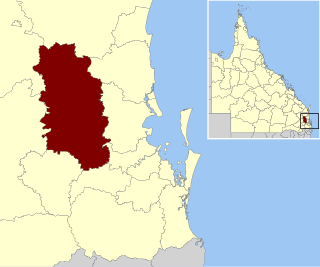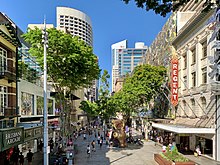
Queensland is a state situated in northeastern Australia, the second-largest and third-most populous Australian state. It is bordered by the Northern Territory, South Australia and New South Wales to the west, southwest and south respectively. To the east, Queensland is bordered by the Coral Sea and the Pacific Ocean. To its north is the Torres Strait, separating the Australian mainland from Papua New Guinea. With an area of 1,852,642 square kilometres (715,309 sq mi), Queensland is the world's sixth-largest sub-national entity; it is larger than all but 15 countries. Due to its size, Queensland's geographical features and climates are diverse, including tropical rainforests, rivers, coral reefs, mountain ranges and sandy beaches in its tropical and sub-tropical coastal regions, as well as deserts and savanna in the semi-arid and desert climatic regions of its interior.

Brisbane is the capital and most populous city of the Australian state of Queensland, and the third-most populous city in Australia and Oceania, with a population of approximately 2.6 million. Brisbane lies at the centre of the South East Queensland metropolitan region, which encompasses a population of around 3.8 million. The Brisbane central business district is situated within a peninsula of the Brisbane River about 15 km (9 mi) from its mouth at Moreton Bay, a bay of the Coral Sea. Brisbane is located in the hilly floodplain of the Brisbane River Valley between Moreton Bay and the Taylor and D'Aguilar mountain ranges. It sprawls across several local government areas, most centrally the City of Brisbane, Australia's most populous local government area. The demonym of Brisbane is "Brisbanite".

Townsville is a city on the north-eastern coast of Queensland, Australia. With a population of 180,820 as of June 2018, it is the largest settlement in North Queensland and is unofficially considered its capital. Townsville hosts a significant number of governmental, community and major business administrative offices for the northern half of the state.

Gladstone is a coastal city in the Gladstone Region, Queensland, Australia. Gladstone, together with Boyne Island and Tannum Sands, had an estimated urban population of 50,317 at August 2021. This urban area covers 246.1 km2 (95.0 sq mi).

Sunshine Coast is a peri-urban region in South East Queensland, Australia. It is the district defined in 1967 as "the area contained in the Shires of Landsborough, Maroochy and Noosa, but excluding Bribie Island". Located 100 km (62 mi) north of the centre of Brisbane in South East Queensland, on the Coral Sea coastline, its urban area spans approximately 60 km (37 mi) of coastline and hinterland from Pelican Waters to Tewantin.

Mackay is a city in the Mackay Region on the eastern or Coral Sea coast of Queensland, Australia. It is located about 970 kilometres (603 mi) north of Brisbane, on the Pioneer River. Mackay is described as being in either Central Queensland or North Queensland, as these regions are not precisely defined. More generally, the area is known as the Mackay–Whitsunday Region. Mackay is nicknamed the sugar capital of Australia because its region produces more than a third of Australia's sugar.

Logan City is a local government area situated within the south of the Brisbane metropolitan area in South East Queensland, Australia. Situated between the City of Brisbane to the north and the City of Gold Coast to the south, the City also borders the Scenic Rim Region, the City of Ipswich, and Redland City LGAs. Logan City is divided into 70 suburbs and 12 divisions; a councillor is elected to each of the latter. The area had a population of 326,615 in June 2018.

Colin Grant Clark was a British and Australian economist and statistician who worked in both the United Kingdom and Australia. He pioneered the use of gross national product (GNP) as the basis for studying national economies.

South East Queensland (SEQ) is a bio-geographical, metropolitan, political and administrative region of the state of Queensland in Australia, with a population of approximately 3.8 million people out of the state's population of 5.1 million.The area covered by South East Queensland varies, depending on the definition of the region, though it tends to include Queensland's three largest cities: the capital city Brisbane; the Gold Coast; and the Sunshine Coast. Its most common use is for political purposes, and covers 35,248 square kilometres (13,609 sq mi) and incorporates 11 local government areas, extending 240 kilometres (150 mi) from Noosa in the north to the Gold Coast and New South Wales border in the south, and 140 kilometres (87 mi) west to Toowoomba.

The State Library of Queensland is the main reference and research library provided to the people of the State of Queensland, Australia, by the state government. Its legislative basis is provided by the Queensland Libraries Act 1988. It contains a significant portion of Queensland's documentary heritage, major reference and research collections, and is an advocate of and partner with public libraries across Queensland. The library is at Kurilpa Point, within the Queensland Cultural Centre on the Brisbane River at South Bank.

The Cairns Convention Centre is a convention and entertainment centre in Cairns, Queensland, Australia. The venue was selected the World's Best Congress Centre in 2004 and 2014.

Springwood is a suburb in the City of Logan, Queensland, Australia. In the 2016 census, Springwood had a population of 9,148 people.

G:link, also known as the Gold Coast Light Rail, is a light rail system serving the Gold Coast in Queensland, Australia, and is the sole light rail system in Queensland. The system forms part of the TransLink's South East Queensland public transport network and consists of a single 20 km (12 mi) line of nineteen stations. Helensvale railway station is the northern terminus of the system, while Broadbeach South is the southern terminus. The line opened on 20 July 2014 and was extended northwest from Gold Coast University Hospital to Helensvale on 17 December 2017.

The Gold Coast is the largest regional city and fastest growing city in Australia. As a result, the Gold Coast has a wide range of public and private transport options from cars and bikes to buses, heavy rail and light rail. The car is the dominant mode of transport in the city with an extensive arterial road network that connects the standard residential streets with major suburbs and motorways.

The Somerset Region is a local government area located in the West Moreton region of South East Queensland, Australia, about 100 kilometres (62 mi) northwest of Brisbane and centred on the town of Esk. It was created in 2008 from a merger of the Shire of Esk and the Shire of Kilcoy. It is commonly known as the Brisbane Valley, due to the Brisbane River which courses through the region, although significant parts of the region lie outside the hydrological Brisbane Valley itself.

The Sunshine Coast Region is a local government area located in the Sunshine Coast district of South East Queensland, Australia.

Cameron Robert Dick is an Australian politician and member of the Labor Party currently serving as the 51st Treasurer of Queensland. He previously served as Minister for State Development, Manufacturing, Infrastructure and Planning and was Minister for Health and Minister for Ambulance Services in the Palaszczuk Ministry. He also served as Attorney-General, Minister for Education and Minister for Industrial Relations in the Bligh government. He is currently a member of the Queensland Legislative Assembly representing the seat of Woodridge.
The economy of Queensland is the third largest economy within Australia. Queensland generated 19.5% of Australia's gross domestic product in the 2008-09 financial year. The economy is primarily built upon mining, agriculture, tourism and financial services. Queensland's main exports are coal, metals, meat and sugar.
The Woolstore Precinct is a residential area in the suburb of Teneriffe in Brisbane, Australia. A former industrial and commercial area, it has undergone urban renewal with preservation and re-purposing of many buildings from the early 20th century. This renewal has been guided by neighbourhood plans formulated by Brisbane City Council, with advice from the Queensland Heritage Council.

Sir Joseph Aloysius Sheehy KBE was an Australian jurist and Senior Puisne Judge of the Queensland Supreme Court. He also served as Administrator of the Government of Queensland in 1965 and 1969, and as Queensland's Lieutenant-Governor, Deputy Governor, Acting Governor and Acting Chief Justice on several occasions.






















